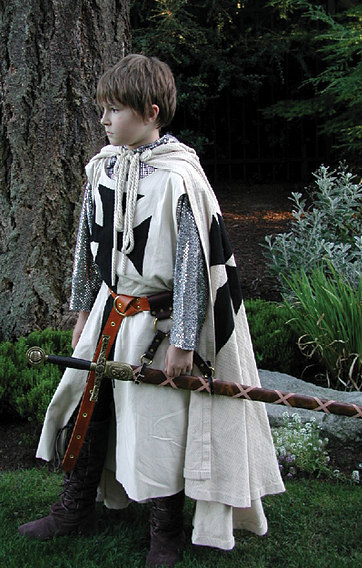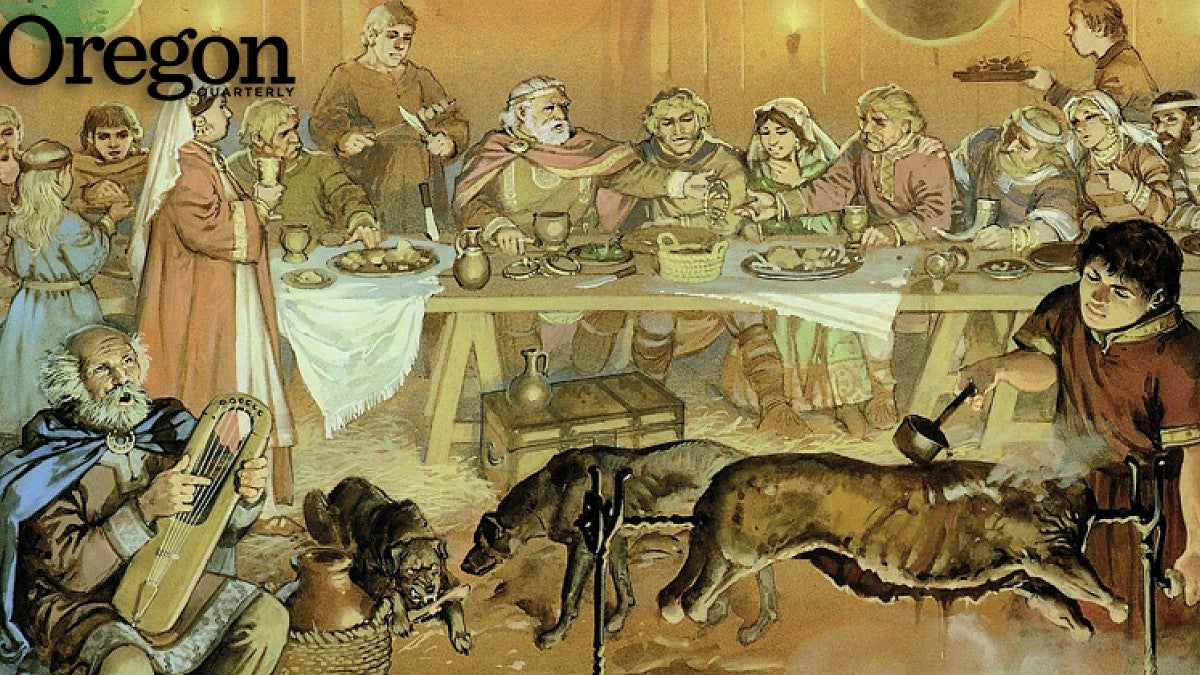James Andersen has been jousting with his dad—actual jousting, as in days of yore—since high school. They don coats of mail and charge toward one another on horseback whilst wielding nine-foot lances with metal tips—under an expert trainer’s watchful eye, of course.
Jousting is among many expressions of Andersen’s fascination with the medieval era, the thousand-year stretch of Western European history that storybook tales associate with chivalrous knights and fair damsels. It extends from the fall of the Western Roman Empire in the fifth century to the arrival of the Renaissance.

“I feel nostalgia for it even though I wasn’t there,” says Andersen, who earned a bachelor’s degree in medieval studies in June. “Some people are born with the medieval bug, and I have it.”
Few universities offer degrees in medieval studies. Andersen discovered the UO’s program through Google searches.
“I knew what I wanted to study, but I wasn’t sure what it was called,” he says. “What made me choose Oregon was how a professor took me under his wing to help me understand the process before I had even applied.”
That professor—Gantt Gurley—is a Scandinavian specialist who now directs the UO’s Harold Schnitzer Family Program in Judaic Studies.
“His work is quite unique and illustrates perfectly the potential of undergraduate research at the highest level,” Gurley says. “He has lit up my office many a morning with his wit and propensity for Scandinavian esoterica. The program will miss him greatly!”
RELATED LINKS
Once on campus, Andersen reported to the rugby club (he played all four years), settled into a steady diet of classics, literature, history, and anthropology (he holds a minor), and developed his facility with languages (he speaks Danish and can read Latin, Old Norse, and German).
“The opportunity to focus on medieval studies is fantastic, and the understanding of human nature that you can acquire is what I love about it,” Andersen says. “Powerful ideas from that period affect our culture in ways that we do not realize, even today. Every time I thought I had a new idea about the Bible, I found out some guy had already written a book about it back in the sixth century.”
The Andersen family’s Danish heritage contributes to his special interest in the seafaring Vikings of the early medieval era. Their superior naval technology—swift, sail-powered longboats—gave them dominion over much of Europe. His pursuit of knowledge about the era seems endless. “I’m that person you never want to go to a museum with because I will read every single little card by every last item on display,” he says with a laugh.
A humanities-oriented major such as medieval studies is ideal for someone like James, who relishes every aspect of the research, thinking, and writing process. When he came up with an uncharted topic—Viking feasts—he was excited to learn that the Office of the Vice President for Research and Innovation offers support to help undergraduates pursue fresh insights into the human experience.

The idea came to him during junior year while he was studying in Denmark. “I steeped myself in everything Viking and did things I’d always dreamed about,” his says, “but one day I realized that I hadn’t read much about feasts.”
Andersen’s professors agreed little was available on the topic and encouraged him to write a thesis, which he titled “A Toast from the High Seat: The Feast in the Viking Age.” An academic journal is considering it for publication.
Through his examination of primary source materials, Andersen developed the theory that feasting was not merely a supplementary cultural event for Vikings. Rather, he says, it was the most important ritual in religious and secular life.
“Feasts show up in many cultures, but for the Scandinavians it was the axle from which all the spokes of Viking Age culture radiated,” he says. “The feast was the event that enforced hierarchies, ratified laws, and added weight to oaths and vows. It was integral to the proper functioning of Viking society.”

Although the UO’s collection of medieval and Renaissance works is the largest in the Pacific Northwest, Andersen needed to buy several rare books that are unavailable through the interlibrary loan program.
“It was a huge relief to learn I could apply for a minigrant through the Undergraduate Research Opportunity Program,” he says. When he discovered he needed more books than the grant covered, the Department of German and Scandinavian made up the difference. Now that his project is completed, the books belong to the UO’s permanent collections.
“I am so grateful for the help,” he says. “The internet is wonderful and libraries are amazing, but you need the actual books to get at the theories and perspectives.”
While spending time on his ancestral turf in Denmark, Andersen joined a club to learn glima, a Scandinavian martial arts system used by Viking men and women for sport and combat. The word is Old Norse for glimpse or flash, which describes techniques for unarmed fighting and for using weapons ranging from knives to axes.
He is concerned about the pressure fellow students felt to choose majors based on a direct connection to careers, a perspective that he shares with his father, a lawyer who majored in history, and his mother, an entrepreneur and consultant.
“I think college is a place you go to with the goal of learning how to learn,” he says. “It’s better to develop skills through the pursuit of knowledge about a topic that fascinates you.”
Now Andersen is preparing to live out a childhood dream that seems like another manifestation of his Viking heritage. Next fall, when he reports to Officer Candidate School at the US naval base in Newport, Rhode Island, he hopes to go into intelligence.
“I have a bit of the Scandinavian spirit for exploration,” he says. “I feel like everything is falling into place.”
--By Melody Ward Leslie, BA ’79 (humanities), staff writer for University Communications
Photos courtesy of James Andersen; Angus McBride, from Germanic Warrior A.D. 236-568 © Osprey Publishing (feast image)


